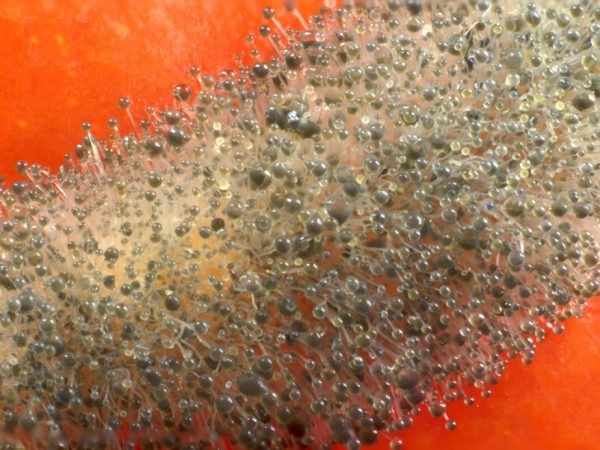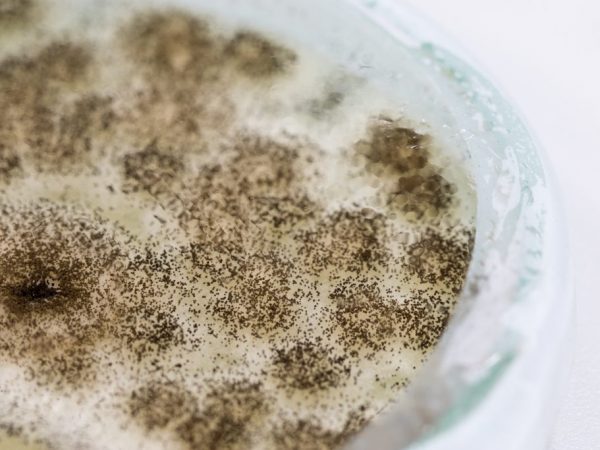Mukor and penicillus molds
Often a fluffy white coating appears on a forgotten piece of bread or cheese. Its scientific name is Mukor mushroom. The affected products are no longer edible, but this type of mushroom is very useful in other industries.

Mucor and penicillum mold
Characteristics of the fungus
Features of mucor
Mukor is a representative of the group of lower mushrooms. It looks like white mold on food, feed and soil. Young mushroom is white or beige, old mold has more black color (“heads” with ripe spores appear). Mukor belongs to molds, therefore it is considered a saprophyte. This means that it feeds on waste from plants, animals and people. It may also be a weakly expressed parasite, because it does not deplete the host's organism.
The structure of the mucor mold: under the microscope, fragments of white elongated bodies with black heads can be seen. White bodies are called sporangiophores. They rise above the mycelium, carrying up rounded, blackening as the formation of spores develops - sporangia. It is the latter that contain the spores by which the species reproduces. Its mycelium is a cell with nuclei.
Mucor mycelium, like all representatives, is extensive. It is unicellular, but contains a large number of nuclei. The area of the mycelium located in the substrate is several tens of times larger than the area of the externally noticeable.
Irina Selyutina (Biologist):
Mukorovye mushrooms occupy a rather isolated position among the rest of the lower mushrooms. They have many common features in the structure of the thallus with oomycetes, but at the same time mucorous ones differ from them in a number of morpho-biological features. Mucorous fungi, with few exceptions, actively develop asexual sporulation, which determines its paramount importance in the distribution and preservation of the species. These fungi are characterized by different complexity in the structure of the apparatus of asexual reproduction, but its main elements are always spore-bearers and spores.
By the way. Mature sporangiospores of mucor are released by rupture or dissolution of the sporangium shell directly from the sporangium. More precisely, experts call them stylosporangia and stylosporngiophores.
Reproduction methods
According to the description, in mucor reproduction takes place in two ways - sexual and asexual. In favorable conditions, he chooses the asexual path with the help of spores. This method helps self-reproduction (this happens throughout the life of the body):
- The shell of the sporangium is torn, and black spores fall on a favorable substrate.
- They can be carried by the wind, carried by people or animals.
- On a moist and nutrient-rich substrate, they germinate, creating new mycelium.
So the life cycle repeats itself. Sexual reproduction occurs when the nutrient substrate is depleted. Then two special cells, gametes, merge, creating a zygote. Over time, it germinates.
Features of penicill
The penicillus mold is a genus of higher saprophytic molds, which occupy the 1st place among soil fungi in terms of their prevalence. They can also be weak plant parasites.
Pelicillas often settle on food, forming a bluish or greenish mold on them. Experiments have shown that, settled next to colonies of bacteria on a nutrient substrate, penicilli fungi kill them.
Morphological features:
- This species is also represented by a eukaryotic structure, only its body consists of many cells, and not one.
- Externally, saprophyte is a greenish or bluish mold that develops in humid places, on food or plant debris. You can find it on the walls in basements and cellars.
The type of reproduction is also different. Most often, multicellular penicilli spreads asexually with the help of conidiophores, on which spores mature.
Irina Selyutina (Biologist):
Mycelium of penicilli is branching, multicellular, colorless. The genus is characterized by certain features in the structure of the conidial apparatus: in its upper part, it represents a brush of varying degrees of complexity, therefore a synonym for the name arose - "brush".
Sexual reproduction (sexual sporulation) occurs by the fusion of globular bodies, spores also form inside them.
Types of mushrooms

Molds come in many varieties.
Mold fungus of the genus Mukor includes about 60 species. The safest and most beneficial for humans:
- Mukor is Chinese.
- Mukor is racemose.
- Mukor is cochlear.
The mold fungus Penicillus, the most common among soil fungi, is characterized by a huge number of species, about 250, for example:
- Penicillus is lemon yellow.
- Penicillus is prostrate.
- Penicillus is common.
Irina Selyutina (Biologist):
Mycelium of penicilli is branching, multicellular, colorless. The genus is characterized by certain features in the structure of the conidial apparatus: in its upper part, it represents a brush of varying degrees of complexity, therefore a synonym for the name arose - "brush".
Mukor and Penicillus mushrooms belong to different taxonomic groups. The genera Aspergillus and Penicillum, which are of colossal importance for industry and medicine, belong to one systematic group - the order Hypomycetes. A well-known producer is Penicillin Rubens, first identified by A. Fleming.
The medicinal properties of molds formed by colonies of penicilli were first noted by Russian scientists V.A. Manassein and A.G. Potebnov back in the 70s. XIX century. They used these molds in the treatment of skin diseases and syphilis.
The total number of sections is 25, they have up to 100 types. A final classification is under development because the level of research is low.
Beneficial features
Despite the popular stereotype about the dangers of mold, this group of living organisms is extremely necessary for wildlife.
All molds are decomposers. This is the name for organisms that are capable of converting the remains of vital activity into organic and simplest inorganic compounds, i.e. destroy.
The remains are created by the consumer (consumer of ready-made organic substances), one of which is the person. The initial link in the food chain is the producer - representatives of the plant kingdom, converting inorganic substances into organic ones.
The importance of mold in nature:
- Provide waste recycling.
- Participate in the nitrogen cycle.
- Maintain balance, saturate the soil with minerals.
Contraindications
Fungus mold is dangerous only for people with weak immunity. Its spores, entering the respiratory tract, begin to multiply and often cause bronchitis, shortness of breath, pneumonia, allergies or mucormycosis.
Such affected foods are not eaten. Cutting off the mold-affected area will not help - the entire surface is already littered with spores.Only 5 of the existing species are especially dangerous for the body.
The genus Penicillus contains both useful and dangerous species for humans. Toxic metabolites are found in 20 types.
They adversely affect the human respiratory system, skin. Particularly dangerous are representatives of the genus Aspergill - black mold. It multiplies rapidly, increasing 9 times per day.
The main risk groups:
- Younger children.
- Elderly people with poor health.
- Allergy sufferers.
- Pregnant women.
Signs of poisoning:
- nausea, vomiting;
- headaches;
- shortness of breath, shortness of breath;
- skin rashes;
- frequent bronchitis, pneumonia.
Application

Mold is used in cooking
Today, the industry is actively using various representatives of the mushroom kingdom to obtain the compounds necessary for humans. Much research is devoted to the survival of organisms in space. Culinary organizations are also interested in the cultivation of mold.
In cooking
Mukor mold is a source of substances in the food industry:
- for the production of fermented food products (soybeans, cereals);
- to obtain ethanol from potatoes;
- for the manufacture of sour milk (as a leaven).
Penicill application:
- In cheese-making for obtaining species with noble mold ("blue cheeses").
- During the production of salami, it prevents the appearance of dangerous plaque, improves consistency, aroma, and reduces acidity.
- For the synthesis of enzymes.
In medicine
Some types of mukor mushroom are suitable for antibiotics. Representatives of the genus Penicillium are used to obtain the most famous antibiotic - penicillin, and from other types of mushrooms are obtained substances griseofulvin, mevastin, mycophenolic acid, used as immunosuppressants.
Growing methods
The easiest way to grow the Mukor mold is on white bread.
Saprophyte loves carbohydrates, so it willingly settles on flour products, potatoes, fruits.
To get moldy bread, you need:
- Moisten a piece of bread with water. It is a favorable substrate.
- Place in a plastic bag or cover with a glass jar on a saucer.
- Keep it in a high humidity environment at a temperature of 20 to 25 ℃. Mold forms up to 37 ℃.
- Over time, a white coating will appear on the piece of bread. If you leave it longer in the same conditions, it will darken due to ripening spores.
Conclusion
White mold on mushrooms has both beneficial properties (it is used in industry and medicine) and negative (food spoilage, diseases). But you will not be able to benefit from them on your own - this is possible only in laboratory conditions. The species multiply by spores and spoil the entire product instantly.



